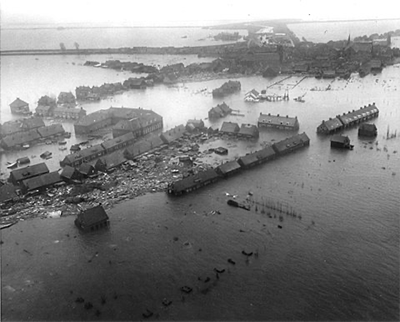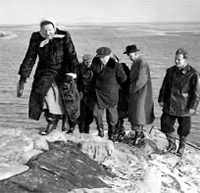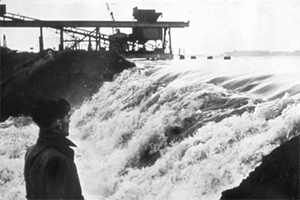The North Sea Flood of 1953
The North Sea Flood of 1953 was the most damaging waterborne disaster in centuries, causing widespread fatalities and damage in Belgium, England, the Netherlands, and Scotland. The flooding occurred on January 31 and February 1, through a combination of strong winds driving a hurricane toward shore, an intense area of low air pressure, and a high spring tide. The resulting tidal surge caused widespread devastation, killing more than 2,500 people and nearly 200,000 animals, destroying or damaging nearly 50,000 buildings, and contaminating thousands of acres of farmland for years to come. The most devastation occurred in the Netherlands, in which half of the land was near or below sea level. A full 9 percent of the total amount of farmland in the Netherlands was flooded. The death toll in that country was more than 1,800, most of them in Zeeland, a province in the south. The death toll was much lower in the other three countries: just more than 300 in England, two dozen in Belgium, and 19 in Scotland. 
People in the Netherlands had scant warning that the flood would be so overwhelming. The Royal Netherlands Meteorological Institutee did issue a warning that the water level resulting from an approaching storm would be dangerously high. But that was one warning delivered twice, at 6:15 p.m. on January 31 and again that same night, just before midnight. In those days, no local Dutch radio station broadcast at night, nor was any local weather station operating past a normal workday close. As well, the flood happened on a Saturday, when emergency offices were generally not staffed. Floodwaters overwhelmed dykes about 3 a.m. in the Dutch provinces of North Brabant, South Holland, and Zeeland. More than 60 miles of seawall collapsed. Then, at 4 p.m. the following day, flooding of an even more dramatic nature occurred in a wider spread of the Dutch countryside, breaking more dykes and driving desperate residents to take shelter on rooftops. More than 300 people in one village alone perished. Animals and people unable to outrun the fast-moving waters floated away to their doom. The rising water levels overwhelmed foundations of tens of thousands of buildings, gutting houses and farms in the process. All of that flooding took out telephone and telegraph networks, and it was amateur radio operators risking their lives to go into flooded areas that kept the outside world apprised of how bad things were at the epicenter of the storm. 
It wasn't until February 2 that rescue brigades in fishing boats sailed into flooded areas. By the next day, an international relief effort had begun, as planes from other countries dropped supplies in to affected areas and Dutch soldiers and volunteers worked to evacuate the tens of thousands of people trapped in the devastation. Relief money poured in to the National Disaster Fund from other countries. Also from other countries came rescue personnel and equipment. Prominent among those helping with the rescue and cleanup were Queen Juliana and her daughter Princess Beatrix. As bad as the flooding was, the government concluded that it could have been worse. The Afsluitdijk, a 15-mile-long dam that was the centerpiece of the Zuiderzee Works, a series of land reclamation elements built at the urging of Juliana's mother, Wilhelmina, had kept the damage from being truly catastrophic. Even so, the queen and government approved the construction of a new set of works, the Delta Works, aimed solely at flood protection. Elsewhere:
As in the Netherlands, governments in Belgium and the U.K. spent large sums of money strengthening their sea defenses. |
|
Social Studies for Kids
copyright 2002–2025
David White



 England: Flooding killed several dozen people and
damaged large amounts of property in Essex, Lincolnshire, and Suffolk. Seafront villages bore the brunt of the storm, but floodwaters in some areas reached nearly 2 miles inland. A handful of ships also foundered in the storm, killing hundreds. As in the Netherlands, communication about the escalation of the weather events was lacking, in part because the storm took out phone lines. One result was the construction of the Thomas Barrier, to protect London from larger surges.
England: Flooding killed several dozen people and
damaged large amounts of property in Essex, Lincolnshire, and Suffolk. Seafront villages bore the brunt of the storm, but floodwaters in some areas reached nearly 2 miles inland. A handful of ships also foundered in the storm, killing hundreds. As in the Netherlands, communication about the escalation of the weather events was lacking, in part because the storm took out phone lines. One result was the construction of the Thomas Barrier, to protect London from larger surges.
